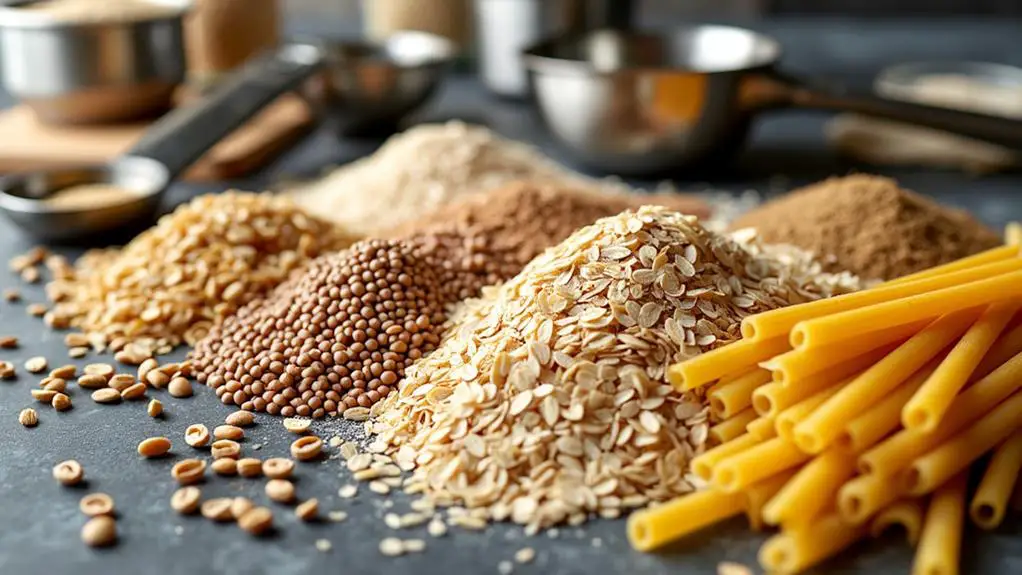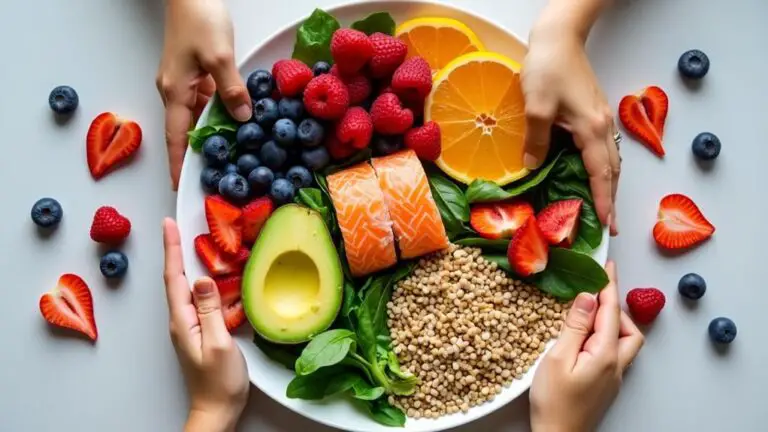Understanding Whole Grains: Incorporating Them Into Family Meals
Whole grains offer numerous health benefits, including improved digestion, reduced disease risk, and better weight management. To incorporate them into family meals, start by checking food labels for "whole grain" as the first ingredient. Swap refined grains for whole grain alternatives, like brown rice instead of white or whole wheat pasta in place of regular. Get creative with kid-friendly recipes using whole grain tortillas, cereals, or breads. When shopping, look for the Whole Grain Council's stamp and aim for at least 3 grams of fiber per serving. Gradually introduce these changes to overcome resistance and involve your family in meal planning. The journey to healthier eating is just beginning.
Key Takeaways
- Gradually introduce whole grains by substituting half of refined grains in familiar recipes.
- Choose kid-friendly whole grain options like whole wheat tortillas for quesadillas or homemade pizza.
- Involve family members in meal planning and preparation to increase interest in whole grain dishes.
- Look for the Whole Grain Council's stamp or "whole grain" as the first ingredient when shopping.
- Highlight health benefits, such as reduced heart disease risk, to encourage family acceptance of whole grains.
Benefits of Whole Grains
Whole grains pack a powerful punch when it comes to your health. They're rich in dietary fiber, which aids digestion and helps lower cholesterol levels, reducing your risk of heart disease.
By incorporating whole grains into your meals, you'll be taking steps to protect yourself against type 2 diabetes and certain cancers, including gastrointestinal cancers.
You'll also benefit from essential nutrients like B vitamins, iron, magnesium, and antioxidants that support your overall health and immune function.
Whole grains can help you manage your weight by promoting satiety and reducing obesity risk.
To reap these health benefits, aim to make at least half of your daily grain intake whole grains, which is about three servings per day.
Identifying Whole Grain Products
Shoppers often find themselves bewildered when trying to identify genuine whole grain products. To make the task easier, start by examining the ingredient list. Look for "whole grain" or "whole wheat" as the first ingredient, indicating a higher whole grain content.
Don't be fooled by color alone, as some whole grain products may appear light due to the absence of added coloring.
The Whole Grain Council's 100% whole grain stamp is a reliable indicator, guaranteeing at least 16 grams of whole grains per serving. FDA-approved health claims on packaging also signal that a product contains at least 51% whole grain ingredients.
When identifying whole grains, avoid products listing enriched flour or simply "flour" as the primary ingredient. These items lack the important nutrients found in whole grains.
Easy Substitutions for Refined Grains

You can easily boost your whole grain intake with simple pantry swaps.
Replace refined grains with whole grain alternatives in your everyday meals and snacks.
For successful whole grain cooking, you'll want to adjust cooking times and liquid ratios, as whole grains often require more of both compared to their refined counterparts.
Simple Pantry Swaps
Making the switch to whole grains doesn't have to be complicated. You can easily incorporate them into your family's healthy diet by making simple pantry swaps. Replace refined grains with whole grain alternatives to boost fiber and nutrient content in your meals.
Here are three easy substitutions to get you started:
- Swap white rice for brown rice or quinoa
- Use whole wheat pasta instead of regular pasta
- Replace all-purpose flour with whole wheat flour in baking
These changes will enhance the nutritional value of your family's meals without greatly altering cooking times or flavors.
For breakfast, choose whole grain cereals like oatmeal or shredded wheat over sugary options. When buying bread, opt for 100% whole grain varieties, ensuring whole grains are listed as the first ingredient.
These small changes can make a big difference in your family's overall health.
Whole Grain Cooking Tips
Building on the idea of simple pantry swaps, let's explore some practical whole grain cooking tips to make your change even smoother.
You can easily substitute white rice with brown rice or quinoa in your recipes, adding fiber and nutrients while enhancing texture and flavor.
When baking, replace half of your all-purpose flour with whole wheat flour to boost health benefits without compromising taste.
Swap refined pasta for whole grain varieties to increase fiber and micronutrient content, making your meals more filling.
Use whole grain bread or wraps for sandwiches to promote better digestion and sustained energy.
For breakfast, choose whole grain cereals with at least 3 grams of fiber per serving to start your day on a healthy note.
These simple substitutions will help you incorporate more whole grains into your family's diet effortlessly.
Kid-Friendly Whole Grain Recipes
You'll find that introducing whole grains to your children's diet can be both easy and enjoyable.
Try serving up some tasty whole grain snacks like quesadillas made with whole wheat tortillas or homemade pizza with a whole grain crust.
For breakfast, you can whip up some whole grain pancakes or muffins that your kids will love, making their morning meal both nutritious and delicious.
Easy Whole Grain Snacks
Numerous kid-friendly whole grain snacks can be easily prepared at home, offering both nutrition and taste.
You'll find that whole grain snacks not only satisfy hunger but also contribute to maintaining a healthy body weight. Try making homemade trail mix with whole grain cereals, nuts, and dried fruits for a balanced, fiber-rich option. Whole grain tortillas can be transformed into fun wraps filled with lean proteins and veggies.
For quick and easy whole grain snacks, consider:
- Popcorn, whole grain crackers, or oatmeal cookies
- Whole grain muffins made with whole wheat flour
- Brown rice cakes topped with nut butter and sliced bananas
These snacks provide essential nutrients while keeping kids energized.
Breakfast Whole Grain Ideas
Every morning presents an opportunity to fuel your kids with nutritious whole grains. Start their day with a bowl of fiber-rich oatmeal, which you can customize with fruits and nuts for added flavor and nutrients.
Whole grain pancakes made from whole wheat flour or oats are a fun breakfast option that kids will love, especially when topped with fresh berries or a drizzle of honey.
For a quick and easy meal, serve whole grain cereals like shredded wheat or bran flakes with low-fat milk or yogurt.
Whole grain toast topped with avocado or nut butter provides a satisfying combination of healthy fats and protein.
Don't forget about whole grain smoothies – add oats or granola for a nutritious boost that's perfect for busy mornings.
These breakfast whole grain ideas will help your family embrace whole grain foods daily.
Shopping for Whole Grains

When you're maneuvering the grocery aisles in search of whole grains, it's crucial to know what to look for. Start by checking food labels for "whole" as the first ingredient, like "whole wheat" or "whole oats." This guarantees you're choosing true whole grain products.
Keep an eye out for the Whole Grain Council's 100% stamp, which indicates all grain ingredients are whole grains.
To make choosing whole grains easier, follow these tips:
- Check the fiber content – aim for at least 3 grams per serving
- Avoid products with "enriched" or "refined" in the ingredient list
- Don't rely on color alone – some whole grains may appear lighter but still be nutritious
Overcoming Resistance to Change
Change can be a tough pill to swallow, especially when it comes to family eating habits. To overcome resistance, start by gradually introducing whole grains into your meals. Replace half of the refined grains with whole grains to ease the shift.
Highlight the health benefits, such as reduced heart disease risk and improved digestion, to motivate your family. Get everyone involved in meal planning and preparation, creating a sense of ownership and excitement about new whole grain recipes.
Experiment with familiar dishes by using whole grain alternatives, like whole grain pasta in favorite recipes. This bridges the gap between old habits and new preferences.
Offer a variety of whole grains, such as quinoa and brown rice, to enhance meal diversity and appeal. By making these small changes and involving your family, you'll find it easier to incorporate whole grains into your diet.
Conclusion
You're now armed with the knowledge to make whole grains a staple in your family's diet. Don't throw in the towel if you face initial resistance. With time and tasty recipes, your family will come to love these nutritious alternatives. Remember, small changes can lead to big health benefits. Keep exploring new whole grain options, and soon you'll wonder how you ever lived without them. Your family's health will thank you!







